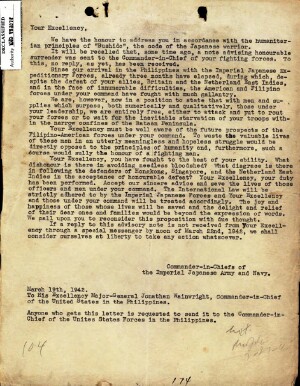The Recognized POW Camps in the Philippine Islands
NARA Data Base for Returned POWS
Back to Main Camp List
| Map
of POW Camps in the Philippines PW Camp #1 - Cabanatuan 1-2-3 Nueva Province Luzon Philippines PW Camp #2 - Davao Mindanao Philippines PW Camp #3 - Old Bilibid Prison Rizal Manila Philippines PW Camp #4 - O'Donnell Tarlac Luzon Philippines PW Camp #5 - Baybombong Luzon Philippines PW Camp #7 - Corregidor Corregidor Is. Philippines PW Camp #8 - Bachrach Garage Manila Luzon Philippines PW Camp #10 - Lipa Batanges Luzon Phillipines PW Camp #10 - Batanges Batanges Luzon Philippines PW Camp #11 - Port Terminal Bldg. Manila Luzon Philippines PW camp #17 - North Central Luzon Luzon Philippines Puerto Princesa Palawan Philippines Philippines Unstated Philippines Camp Holmes (civ) Baguio Luzon Philippines Davao (civ) Mindanao Philippines Los Banos (Civ) Laguna Luzon Philippines Manila Area (Civ) Philippines Nichols Pasay Airfield Santo Tomas (PW and Civ) Manila Luzon Philippines Iloilo Camp (Civ) Iloilo City Panay Philippines Cebu Camp Cebu Philippines Cebu
roster courtesy of Pamela Brink:
Bacolod (Civ) Negros Is. Philippines"Basically the letter was to be sent to relatives to let them know their relatives were alive. The letter from Lucy W. Brown was sent to my aunt for her to forward. It is a good list and as far as I know the only list of the Cebu internees in 1942." San Juan (Civ) Luzon Philippines Christ The King Seminary Quezon City Luzon Philippines Tacloban Leyte Philippines Ateneo De Manila (Civ) Manila Luzon Philippines Sakura Prison Hospital, Fort McKinley, Luzon (RG 407 Box 47) Folder 1: Special Orders, Rosters,
Payrolls, Council Book, Official Diary. Nov 1944-Jan 1945.
Folder is in poor condition. Mostly U.S. POWs and civilians, but
a few British, Dutch, Swedish, Czech, Norwegian, Bohemian,
Russian and Polish individuals also. Camp map.
The following camp list is compiled from submissions by former POWS. No Philippine camps were listed in submissions by Japanese as the Philippines had been recaptured by the Allies. Bachrach
Garage
Detail
Baguio Civilian Camp #3 - Roster (RG 389 Box 2070); Conditional releases; deaths; nurses, etc. (RG 389 Box 2070) Bataan Bilibid- central POW camp in Manila Dr Kentner's Journal [Report on Bilibid- Tagalog for "prison or jail"] Cabanatuan #1 Camp Desc and Rescue Roster. Good camp info here. Cabantuan #3 [see references in above report, Cabanatuan Report #1] Camp Murphy - Rizal- Departure Levy to the Noto Maru (150 men) Capas Casisang External Link- Narrative Cebu Clark Field Corregidor 92nd Garage Corregidor #7 (22 men- 4 survivors- rescued in airborne assault) roster pending Corregidor #9- located at old station hospital between "Middleside and Topside for approximately 10 months" per research of Robert Piland (Col Wright's diary- has list of 223 military and civilian prisoners, pg 183-186) Davao - Camp #502- Davao Penal Colony DEPOCOL Fort Hughes Las Pinas Lipa- Batangas [air strip construction] Los Banos Civilian Camp #2 Manila Port Detail - Camp #11 Malabalay - interim camp on Mindanao closed Oct 1942 men moved to Davao Muntinlupa [New Bilibid] Nichols Field [Pasay School Camp} Officially Camp #5 (Gruenzner, 1979) Nielson Field O'Donnell (Provost Marshall Report with footnotes) Officially Camp #4 (Gruenzner, 1979) Good camp info here. Palawan (Puerto Princesa) Roster of massacre victims. For more information, see these PDF files: Palawan Atrocity Summary of August 18, 1945 (including Amb. Joseph Grew's protest letter of May 19, 1945, to Japanese Govt.); Massacre at Palawan, YANK magazine, April 20, 1945 issue; The Palawan Massacre, ATIS 1946-05-15 (Chapters: Situation, Event, Historical Background) San Fernando Santo Tomas Civilian Camp #1 EXTERNAL
LINKS [Link
#1] worth visiting [Link
#2]
The BEST for individual stories and the complete story,
plus a great DVD movie about the camp. See also articles
in
LIFE magazine. See this
collection
of documents re the deaths of Grinnell, Duggleby,
Johnson and Larsen.
Tarlac (held high ranking officers before shipment to
Taiwan/Formosa)Santo Tomas roster (RG 389 Box 2070) Conditional releases; deaths; nurses, etc. (RG 389 Box 2070) Zamboanga History and Information on Philippine Islands Camps: Cooper Report on Medical Activities in the Philippines and Japan Prisoners of War in the Philippine Islands Office of the Provost Marshal General Report on POWs in the Philippines Death Was Part of Our Life, LIFE magazine, Feb. 7, 1944 issue Statistics on all POWs in the Philippines as of Oct.15, 1943 (JPG) Story of escape from Davao Penal Colony, Philippines: Ten Escape From Tojo; related PDF download of The Dyess Story Ghosts of Bataan documentary - Roger Mansell credited in this video Guerrillas in the Philippines - excellent research by John Lewis, including section on guerrilla submarine missions to the Philippines Philippine Scouts roster (RG 407 Box 6) - alpha listing including organization Typical Japanese Atrocities During the Liberation of Philippines 1945-09-12 (transcription courtesy of Scott Proudfit) Philippines atrocities, statements and photos (from CARL) **WARNING - GRAPHIC!** Disposition of All POWs in Philippines Oct1943 - in process Military Units in the Philippines - PDF list from The Quan Asst_Images_of_Bataan-Cabanatuan-Bilibid-ODonnell-Davao (PDF) - great assortment of images, courtesy of Frank Blazich; contents text file - Email us for hi-res images RG 496_Box 40_Road_and_Trail_Map_of_Bataan_Peninsula_1942-01-04 (PDF) - huge map, total of 32 tiles; courtesy of Frank Blazich Many links about civilian camps and military prisons: POW/INTERNMENT CAMPS IN ASIA DURING WWII Asst. Place Name Cards for Java Camp Group Area (RG 153 Box 7, JAG files) - cards are mixed in with other area camps, contain many names and places relating to deaths, news events, atrocities, etc. Interim Rosters for Santo Tomas, Los Banos, Baguio, Davao, Tacloban and Tagbiliran (RG 389 Box 2202) - Civilian rosters produced in May~July 1943 (see Contents on p. 10) PHILIPPINES - Civilian camps (RG 389 Box 2201) - Prelim rosters of all nationalities Draft Roster of Transfers to Japan (RG 407 Box 55) - POWs shipped to Japan Recovery of Personnel Log Sheet (RG 407 Box 55) - Recovered POW list, on board hospital ships USS Sanctuary and USS Consolation; includes Beach Hospital Draft rosters (RG 407 Box 57) - Preliminary POW roster of Americans, details unknown Medical records (RG 407 Box 169) -Individual Medical Records (1942-43) of American civilians living in the Philippines; American civilian and military death certificates (March 1943) Death certificates (RG 407 Boxes 170, 171) - August-November 1942. Translations of death certificates, Philippines POW camps; mostly American or Anglo names; nationalities not listed. Fifty pages only, total around 1200 pages. Graves Registration Records 1944-1946 Part 1 - Part 2 (RG 338 Box 532) - Burial records, isolated graves, records of deceased of various Infantry Divisions (6th thru 43rd): Folder 1: "Base Internment - June
1945 Burial records. All U.S. POWs." U.S.A.F. Cemetery, Santa
Barbara No. 1, Luzon, Philippines
Philippine
General Hospital, SS Acadia Passenger Lists (RG 407 Box
1529):Folder 2: February - June, 1945 Grave registrations - American POWs and some Filipinos Folder 3: 43D and 158RCT - February 1945 Deceased personnel - American and Filipino POWs Folder 4: March - June 1945 Deceased personnel - mostly U.S. and some Filipinos Folder 5: June - August 1945 Deceased personnel - mostly U.S., some Filipinos and Japanese Folder 6: February - August 1945 Recorded burials - U.S. and Filipino, some Japanese and Chinese Folder 7: April - June 1945 Deceased personnel - U.S. and Filipino, some Japanese Folder 8: Recovery of Deceased Personnel - Sixth Army - 1945 Mostly Philippines, some Dutch New Guinea - burials, maps, grave locations - U.S., some Filipinos and Japanese POWs Folder 9: Graves Register - January - July 1945 Deceased by Division Folders 1, 2: Philippine General
Hospital lists - American, British, Dutch civilians, male and
female
Capalonga
soldiers (RG 407 Box 123) - Report about six American
soldiers who were cared for and protected in Capalonga,
Camarines Norte. Sept 22, 1945.Folder 3: Passenger List SS Acadia - Cuban, American, Chinese, and Filipino Folder 4: Passenger Lists for USS Clarence Roberts, USS General Bundy, USS Langfette, USS General Sturgis, USS Marine Panther, USS Sea Skimmer, USS Octorara, USS Marine Fox, and USS General Pope - Dutch, American, French, Stateless, British, and Panamanian (NOTE: Only a few pages photographed) Folder 5: Philippine Scouts Returned to Military Control ATIS Bulletins, Philippines and Java, May-July 1945 Visayan-Mindanao Force (RG 407 Box 47) - Miscellaneous Roster, Correspondence, Orders, Memoranda. 1941-42; roster mostly US POWs. Los Banos (RG 407 Box 200): Folder 1: List of people,
irrespective of nationality or position who have assisted
internees - Los Banos - March 1945. Includes Indian, Korean,
German, Japanese, American, Filipino, Spanish, Chinese, Swiss
and Portuguese civilians.
Santo
Tomas Morale Report (RG 407
Box 200):Folder 2: Los Banos Internment Camp "Readers Digest" Aug 1943 - Digest of Reader's Digests." Assortment of articles, including thoughts on a post-War Europe, political commentaries, situation in China, etc. Folder 3: List of people, irrespective of nationality or position who have assisted internees - Los Banos - March 1945. Includes American, Filipino, Korean, Japanese, Dutch, Swiss, Chinese, Spanish, Swedish, Yugoslavian, Indian and German civilians. Folder 4: List of people, irrespective of nationality or position who have assisted internees - Los Banos - March 1945. Includes American, Filipino, Chinese, Swiss, Russian-Greek, Japanese, German, Danish, British, Spanish, French, Indian and Dutch civilians. Folder 14: Los Banos Internment Camp - Roster of internees and administrative orders and memorandums 1943-45. Address to the camp on January 7, 1945; letter to camp commandant; camp reorganization & other administrative reports. American, Japanese internees referenced. Roster of internees transferred - all American. Folder 5: Morale of Santo Tomas Internee Camp, File 9 - List 1. Typed report on the morale of Americans after 22 months. War Claims (RG 407 Box 200): Folder 6: War Claims - Includes
claim instructions & forms for ex-internees, also legal
definition, process and reports.
Folder 7: Hickman, Herbert William / Ward - Unresolved. Incomplete claim. Folder 8: POWs, Escaped Soldiers, Internees (Loans and Aid to). Philippines - Meritless and valid claims and appllications. Folder 9: Red Cross Claims. Claims to the American Red Cross for damages. Folder 10: Commissions, Foreign Nationals. Includes British claimants. VIDEOS - Roderick Hall Collection, WWII in the Philippines General Masaharu Homma - Asst. news articles during war crimes trials Japanese Imperial Letter to Gen.
Wainwright
March 19, 1942
About
the Bataan Death March
Courtesy of Jim Erickson:
Regarding the number of deaths on the March -- It is true we will never know with certainty, but we now have a much better idea than even a few years ago. It is certain that no more than 300 Americans died on the March. That upper limit comes from researchers working with DPAA records. It is, however, likely an overestimate as it includes every missing American that could potentially have died on the March. From my work, I think the most likely number is less than 200. As to Filipino deaths we can only make crude estimates. A reasonable ball park figure would be 10X the number of American deaths in the comparable period. Given that Filipinos, not Americans, perished in the Pantingan massacre it would be reasonable to bump the estimate a bit and say that a reasonable crude estimate would be that some 2,500 Filipinos perished on the March. Courtesy of Fred Baldassarre: The best available estimates on the number of deaths on the March was closer to 200 to 250 for Americans and around 2,000 to 2,500 for Filipinos. Also the Philippine army was a separate Commonwealth Army. They had their own divisions and, when available, their own generals. Gen. Lim was in charge of the 41st Division. Gen Capinpin was in charge of the 21st Division. There were simply not enough Filipino generals, at that time, so US Colonels quickly promoted to Brig. Generals were put in place. They were a part of the USAFFE Command which was an American Command led by MacArthur. It is confusing... On Bataan there were around 74,000 Filipinos and around 11,870 Americans under the Luzon Force Command, divided up into I Corps and II Corps. There were a small quantity of US Navy and US Marines under the command of the 16th Naval district, but most of them were evacuated prior to the surrender. The best estimates are that approximately 10,000 Americans and 60,000 Filipinos began the March. Your chances of surviving the March and captivity depended for the most part on your physical condition in which your entered captivity, and over-all the Filipinos were in much worse physical condition than the Americans. Most of the front lines (MLR) were manned by the Filipinos, this means that the Filipinos were furthest away from the supply depots in the rear. Due to the terrain, the lack of navigable roads and the Japanese complete control of the air, moving supplies from the depots to the front lines was very difficult and in some cases impossible. The QM trucks would lose track of the positions of the front lines troops and in some occasions they were subject to being attacked. Also, since the Japanese planes flew in the skies above them, undisturbed, the trips from the depots to the front lines were usually done at night at a very slow pace. Some units went several days without being re-supplied. Life in the front lines was much more exhausting and rigorous than life in the rear, which means the Filipinos in the front were in dire need of a higher caloric diet which the conditions made impossible to provide. A poor diet negatively affected their immune systems. Internal and external infections were a major problem. Aside from a lack of food, there was also a lack of medical supplies, and specifically quinine, which was used for treating the fevers that come with malaria. As per the Dr. Gillespie report, the enlisted ranks of the Philippine Commonwealth Army were not issued quinine to be used as a prophylactic. Once they were sick and in one of the field hospitals they were given quinine, but not for the use as a prophylactic. The prophylactic use of quinine was limited to officers (Filipino and American), Philippine Scouts and American enlisted personnel, until the very end, when the quinine supply finally stopped. Also, as bad as the US officers were, the Filipinos officers were much, much worse and far more self-serving (of course there were some exceptions). Many of the Filipino officers were college boys from affluent families, with "some ROTC." Also most only spoke Tagalog, English and some Spanish, but very few spoke the local dialects of their enlisted ranks. As a result, with the exception of two or three divisions, training and discipline was either very poor or simply non-existent. The lack of training and discipline not only affected their performance as fighting men, but it also affected their hygiene and sanitary habits. They made life worse for themselves by not properly digging slit trenches for their toilet functions. In many cases, they dug these slit trenches too close to their kitchens. Also, much of the available water in the streams and rivers of Bataan was not safe to drink unless it was first treated. Many would treat the water with iodine. Since the enlisted ranks of the Philippine Army lack the basic discipline required by a soldier, in many case they would drink the untreated water and so infecting themselves with dysentery. These factors mentioned above, when combined together, increased the exhaustion and stress levels of the Filipino enlisted men. The Americans also had similar factors and conditions, but, for the most part, they were not as common or as extreme as the Filipinos. Since the Filipinos outnumbered the Americans by 6 to 1, it became far more evident in their ranks. As seen with their behavior in the China incidences, the Japanese proved to be a racist bunch. They would refer to the Chinese as "cockroaches." This racist attitude extended to their attitude and treatment of other Asians. They were far more brutal in the treatment of Filipino soldiers and Filipino civilians. At one point during the March, they gathered around 300 Filipino officers and non-coms and massacred them in one spot, the Pantingan River Massacre. As you can see, many factors contributed to the high mortality rate of Filipino soldiers. I am certain I left many out. See: Felix and Vargas interviews re Pantingan Massacre - Trial of General Homma Statistics regarding the men on Bataan and Corregidor (by Robert Hudson): In the last two weeks before
surrender, there were 150 non-battle-related deaths per day due
to disease and malnutrition.
At Camp O'Donnell, from which Corregidor men were spared, in six weeks, 2,534 Americans and as many as 22,000 Filipinos died. These deaths can be attributed largely to the condition these men were in after surviving the march. When the Bataan men were moved to Cabanatuan, the Corregidor men were there watching them come in and were aghast at the horrible condition they were in. In the first month at Cabanatuan, 1,300 Bataan men died as opposed to 37 Corregidor men. Between 1942 and 1944, there were 2,636 total POW deaths at Cabanatuan -- 2,399 men from Bataan and 237 from Corregidor. After a few weeks in Cabanatuan, all POW's were in the same poor condition. It stands to reason, then, that the majority of POW's who died on hell ships were from Corregidor because within six months after the surrender, half of the Bataan men were dead. Remember the Iligan Death March (Mindanao Death March) by MIndy Kotler Smith The Bataan Death March -- the
merciless 65-mile trek by American and Filipino POWs up the
Bataan Peninsula from Mariveles to San Fernando -- is part of
the American language and lore. Many have some vague recognition
of the war crime, although few know what happened, where, or
when. April 9th is better remembered as the surrender at
Appomattox than the surrender on Bataan.
But at least there is some effort not to forget. At the Tokyo War Crimes Tribunal held between May 1946 to November 1948, the Philippine Prosecution Team presented and proved before the court 16 incidents of indignities, torture and barbarities committed against the Filipino and foreign Prisoners of Wars (POWs) and civilians. All were well-documented and easily proven. The Bataan Death March was already a legend by the time the trial started because of the sensational series articles about the March published in the Chicago Tribune in January 1944. The articles, turned into a book, were an account of the brutalities experienced by Col William Dyess who had escaped from a POW camp in the Philippines. Dyess, unfortunately, had died in a flight training accident in December 1943. Among the 16 war crimes was the Iligan Death March or the Mindanao Death March. Although Gen. Sharp officially surrendered the Mindanao-Visayan Force on May 10th, 1942, the final surrender of units in the Lake Lanao area under Brigadier Gen. Guy C. Fort did not take place until May 28, 1942. He surrendered at Camp Keithly approximately 300 Filipinos and 46 Americans (civilian and military) to the Japanese. Fort was executed by the Japanese on November 11, 1942. He is the only American-born general officer to be executed by enemy forces. On July 4, 1942, the POWs were made to march from Camp Keithly at Dansalan (now Marawi) to Iligan, Lanao, a distance of about 25 miles (36 kilometers). Transport trucks, although available, were denied the POWs. The Americans were arranged four abreast and strung together in columns by a gauge wire through their belts. The Filipino POWs, though unwired, had to walk barefooted. The March lasted from 8:00am to 7:00pm. The midday sun was unbearable. Without food and water, many of the men collapsed due to exhaustion and dehydration. Those who fell were shot in the forehead so they would not be rescued by guerrillas. Few of the Americans on March survived the entire war. Among those that did, four are known to have recorded their memories of the March. They were: Victor L. Mapes, Herbert L. Zincke, Richard P. Beck and Frederick M. Fullerton, Jr. All have their accounts recorded by the Library of Congress' Veterans History Project. Zincke published his account in his autobiography, Mitsui Madhouse: Memoir of a U.S. Army Air Corps POW in World War II (2002). Mapes published his account in his autobiography, Butchers, the Baker: The World War II Memoir of a United States Army Air Corps Soldier Captured by the Japanese in the Philippines (2000). You can read more about the March here: https://www.metrocdo.com/2021/04/04/the-mindanao-death-march/ and here: https://www.ijicc.net/images/vol11iss7/11738_Donesa_2020_E_R.pdf There is still more research needed on this atrocity. A summary of the Philippines Prosecution Team's charging document is here: POW Summation - Appendix B, Part II Summary of Evidence in Relation to Treatment of Prisoners-of-War, Civilian Internees and Inhabitants of the Philippine Islands Between December 1941 and September 1945. https://dl.ndl.go.jp/info:ndljp/pid/10282465 (p 24, F. Iligan Death March 106) The Japanese mockingly dubbed the Iligan Death March the gIndependence Day March.h Philippine Philatelist: Prisoner of War Camps in the Philippines - Interesting collection of postcards and other documents from POWs in Philippine camps Bataan Missing Dedicated to the thousands of American servicemen who were imprisoned and died of starvation, disease and mistreatment on the Bataan Death March and in Japanese prison camps in the Philippines Cabanatuan Burial Roster 2nd General Hospital (Personnel Roster) History of 2nd General Hospital by LTC Jack Schwartz 1977 Commemorative Envelopes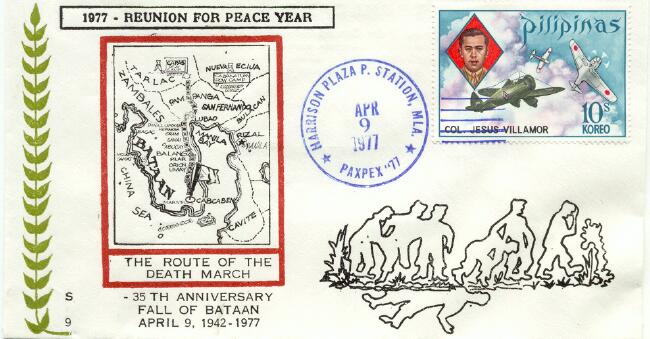 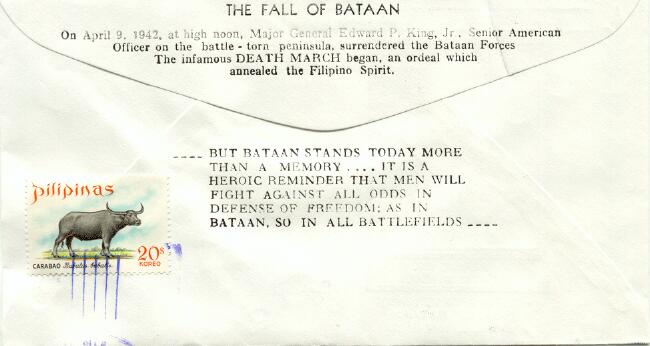 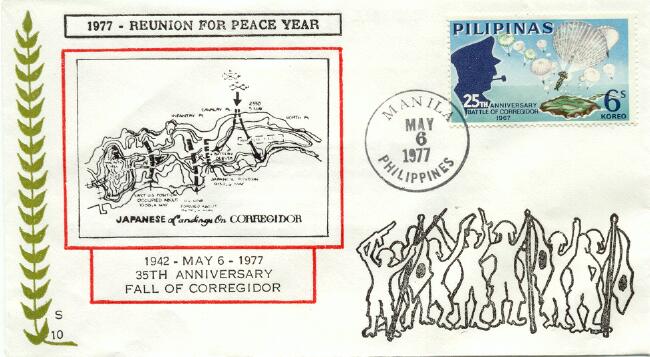 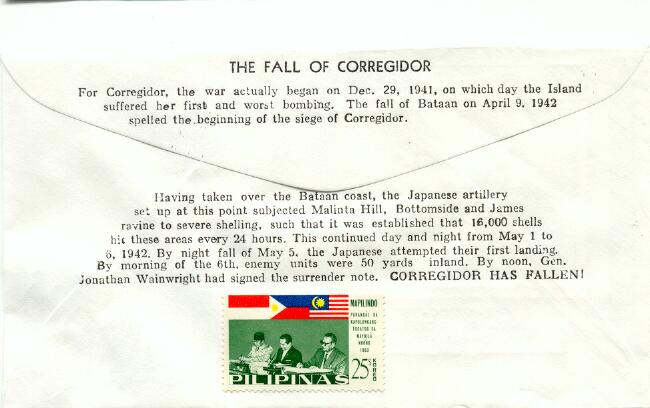 |
